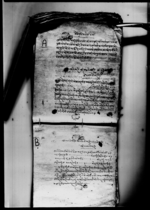A copy of a lālamohara from King Gīrvāṇayuddha re the purchase of rams and he-goats for Dasaĩ rituals in Gorkha (VS 1863)
ID: K_0030_0050A
Edited and
translated by Astrid Zotter
Created: 2016-09-08;
Last modified: 2023-02-10
For the metadata of the document, click here
The accompanying edition, translation/synopsis and/or commentary are available under the terms of the Creative Commons Attribution-ShareAlike 4.0 International License
Abstract
The lālamohara of which this is a copy addresses the administrators (amālidāras) and the general public between the Naṃḍī and the Mādī rivers. Because special breeds of sheep and goats are required for the Dasaĩ rituals at Gorkha, it orders that they be sold by cattle breeders at prices fixed by the local authorities. Such sales are declared mandatory, and those refusing deemed rebels.Diplomatic edition
[1r]
1⟪२५८⟫[Seal of the Jaisīkoṭhā][Unknown seal]12आगेनंडीपछीमादीपुर्वकाअमालीदारप्रतीचारैवर्णछतीसजात
3प्रतीगोर्षाकादसैघरश्री७देवताकापुजागर्दाकाग्याभेडापुवारवो
4क्याटुलोचोषोचाहींछनभैहुदैनतसर्थजसलेपाल्याकोछपंचले
5ठहरायाकोवाजवीमोलपाईकननदीन्येरपुजाअडकाउनामाजो
6पसलाअपसरीय़ाहोलाइतीमीतीसडर¯¯¯¯¯¯ ¯¯¯¯¯¯ ¯¯¯¯¯¯
Translation
[1r]
[no.] 258 1
Āge: To the amālidāras west of the Naṃḍī and east of the Mādī [rivers], to the four estates and 36 castes.
When worship is performed for the sevenfold glorious (śrī 7) deity of Gorkha's dasaĩghara, rams of the kāgyā-type (kāge bheḍā) and he-goats of the puvāla-type, big and pure, are needed. Without them [worship] cannot be [performed]. Therefore he who has raised [such animals] and does not give [them], even if he were to receive the appropriate price fixed by the local council (pañca), and who [thereby] becomes entangled in hindering the worship will be [considered] a rebel.
The date is confirmed.
Commentary
This lālamohara concerns the provision of sacrificial animals for the "sevenfold glorious deity of Gorkha's dasaĩghara." It is likely to be related to the sacrifices performed during the Dasaĩ festival at Gorkha Palace. The use of "sevenfold glorious" (śrī 7) in it is remarkable. In other contexts, deities are said to be either "śrī 3" or "śrī 5". An alternative translation would be: "the glorious seven deities of Gorkha's dasaĩgharas." It that case it could refer to the group of seven deities who mark the core territory of the kingdom of Gorkha, there conceived of as Seven Sisters, of which Kālikā of Gorkha Palace is held to be the eldest (see Unbescheid 1996: 104–105)

